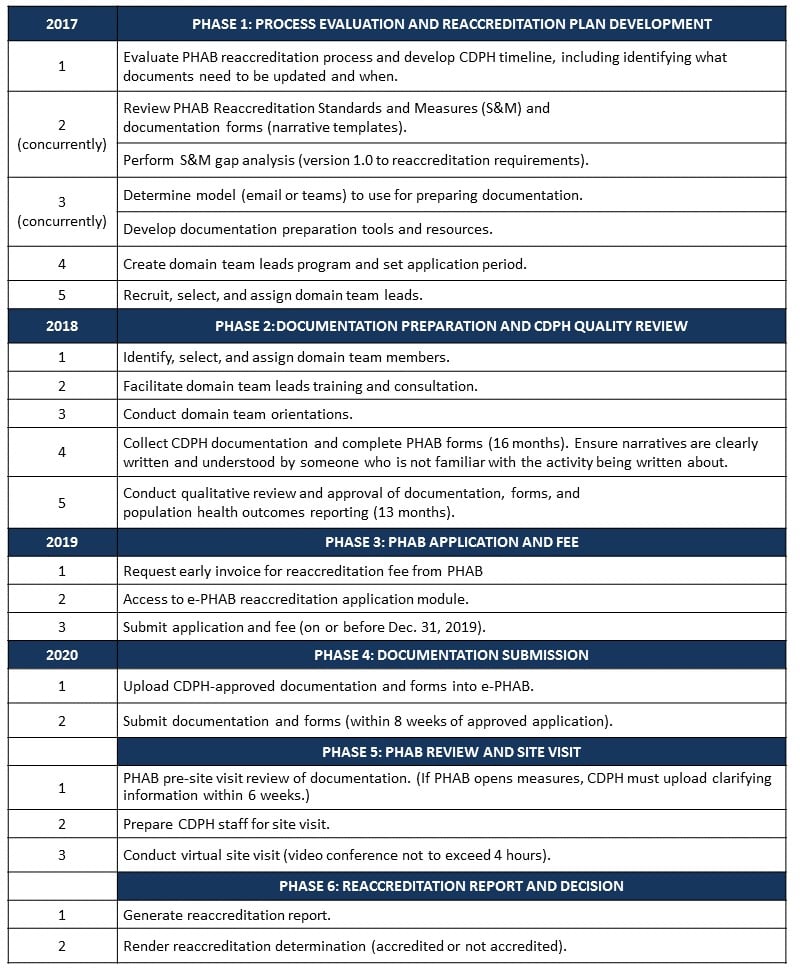California Shares Insights on Preparing for Reaccreditation
July 17, 2018 | Jamie Ishcomer
National public health accreditation enables health departments to provide high-quality public health services to the community. According to the Public Health Accreditation Board (PHAB), accredited health departments play an important role in promoting population health with services that reach over 214 million individuals all across the nation. The accreditation process helps health departments identify strengths and weaknesses and undertake performance management and quality improvement (QI) initiatives. It also provides a framework for health departments to improve external relationships with their governing entities and other stakeholders and their communities.
PHAB first awarded accreditation to 11 state and local health departments on Feb. 28, 2013, and has since accredited 29 additional state health departments, including Washington, D.C. Public health accreditation is granted for five years, similar to accreditation processes for academic institutions, healthcare facilities, and other industries. After five years, health departments must apply for reaccreditation, building upon previous efforts and using the resulting plans, policies, procedures, and capabilities for improved accountability and continuous QI.
Now, with their initial terms set to expire, the California Department of Public Health (CDPH) and several other health departments are gearing up to apply for reaccreditation. ASTHO spoke with CDPH’s accreditation coordinator, Leslie Stribling, about the department’s path to reaccreditation. As other health departments prepare for reaccreditation, Stribling recommends three strategies to get organized, engage others in the process, and apply lessons learned.
Strategy 1: Prepare for reaccreditation early, leverage information submitted through annual reports, and develop an accreditation sustainability plan and roadmap.
Reaccreditation builds upon a health department’s initial accreditation efforts, so don’t wait until the five-year mark to get started, advises Stribling. Through annual reports, health departments demonstrate to PHAB both functional improvements and that they are meeting the milestones outlined in the PHAB Standards and Measures. CDPH uses annual reporting as an opportunity to point out which of the agency’s practices resulted in better processes or services. To prepare for reaccreditation, CDPH first combined content from its annual reports and guidance from PHAB’s documentation forms and examples of good and bad narratives. These robust reports highlight ongoing programmatic work and can be used to inform reaccreditation discussions and narratives that tell the story of a health department’s progress toward a QI-oriented culture.
CDPH also encourages other health departments to start preparing for reaccreditation early by developing an accreditation sustainability plan or roadmap to complete the major tasks associated with reaccreditation. CDPH recommends breaking down reaccreditation activities into manageable phases, as shown below. This approach allows department staff to set priorities, determine goals, and allocate the resources needed to support reaccreditation activities.

Strategy 2: Keep leadership and staff engaged in the process.
Stribling says keeping agency leaders and staff involved in accreditation activities is critical, both prior to receiving initial accreditation and in the years following. Their engagement ensures that everyone in the department knows their role in sustaining a culture of quality and providing the best possible public health services to the community.
CDPH leadership actively supports reaccreditation and sees it as a driver for ongoing, department-wide QI to develop and enhance processes that ultimately improve agency functions. The director and state public health officer will review and approve each document before it gets submitted to PHAB. Staff at all levels help plan and implement activities integral to the department’s reaccreditation efforts. To foster collaboration, professional development, and growth, the agency developed a program for the team leads responsible for each domain of reaccreditation. The CDPH Domain Team Leads Program is designed to advance participants’ technical knowledge of the PHAB reaccreditation process and enhance professional competencies for existing and emerging leaders.
Strategy 3: Apply to reaccreditation both best practices and lessons learned from initial accreditation.
PHAB developed the accreditation model to drive a culture of continuous QI through data-driven decision making. The same approach—utilizing best practices and lessons learned to inform improvements—can and should be extended to health department reaccreditation efforts.
CDPH identified four best practices from initial accreditation and applied them to reaccreditation, including:
- strategic direction (derive strategies and timelines to achieve deliverables, assess needs and allocate resources, and collaborate cross-sectorally).
- staff engagement (engage executive and emerging leaders, message accreditation intent and connection to programs and staff, and foster team culture).
- systems-level QI (standardize documentation storage and tracking, utilize shared electronic platform, and describe department efforts to advance quality and performance).
- technical assistance (facilitate reaccreditation training and provide coaching to individuals, teams, and programs).
Health departments can identify agency best practices and lessons learned from previous work by revisiting their department’s SWOT (strengths, weaknesses, opportunities, and threats) analysis. By comparing the outcomes and priorities illustrated in the SWOT analysis with the initial accreditation site visit report and annual report feedback, states can identify overlaps in opportunities for improvement and prioritize departmental efforts to address them.
Reaccreditation is just as rewarding and important to advancing a health department’s performance as initial accreditation. Getting through the process doesn’t have to be an overwhelming or burdensome endeavor. By starting early, involving leadership and department staff, and building upon lessons learned during initial accreditation, health departments will be more equipped to seamlessly meet the reaccreditation requirements and continue to make meaningful contributions both to their communities and to the public health field.
This work was supported by funds made available from the Centers for Disease Control and Prevention, Center for State, Tribal, Local and Territorial Support (proposed). The content, findings, and conclusions shared are those of the authors and do not necessarily reflect the official position of or endorsement by the Centers for Disease Control and Prevention.